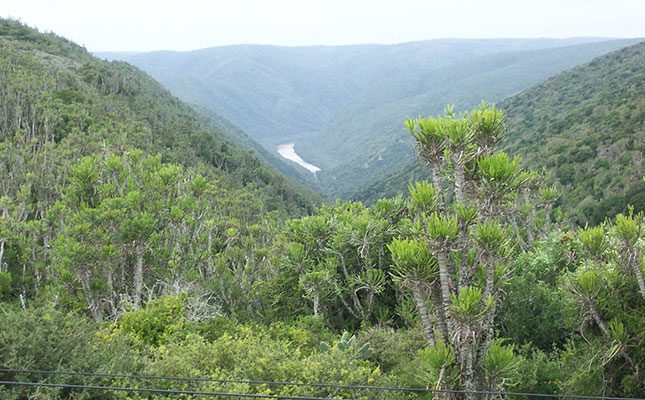
Photo: Gareth McAlister
Luvuyo Ncula, a technician at the Rhodes Restoration Research Group (RRRG) in the Eastern Cape, is overcome with emotion when he sees his ‘plant babies’ growing in the blazing sun.
He nurtured the seeds, collected from parent trees in the nearby thicket, in tunnels at the Rhodes University Waainek Research Facility until the seedlings were big enough to be moved into the shade house in his nursery.
It was here that they began to flourish in his special growing medium, a rich mix of potting soil and river sand, as well as ground coir and vermiculite for good drainage.
When funds at the facility were short, he cared for the plants on his own, ensuring they had enough water to grow big and strong enough to take on the tough job of restoring areas of degraded subtropical thicket in the Tanglewood Conservation Area, about 47km outside of Makhanda.
Overgrazed land loses its ability to absorb rain and erodes easily. The soil microbes die and a hard crust forms on the soil where nothing wants to grow, or it becomes a dust bowl, equally hostile to plants and animals.
Ncula’s 2 200 young trees had a great future ahead of them when, in 2022, they were transported to a 1ha plot in the Tanglewood Conservation Are, thanks to a grant from adventurer Kingsley Holgate aimed at offsetting the carbon emissions from his 30 000km transcontinental expedition across the length of Africa and Europe.
Planted in groups of 10 in shallow depressions in the hard, bare soil to capture and retain as much rain as possible, they are a mix of shrubby trees such as needle bush (Azima tetracantha) and larger species such as the Cape ash (Ekebergia capensis) and wild plum (Harpephyllum caffrum).
The area was fenced to prevent kudu and other wildlife from browsing them before they could establish themselves on the sun-baked banks of the Bushman’s River.
Tough reality
A year later, it’s Ncula first visit to see how his trees are doing. A few are standing proud, putting out healthy green leaves, while others are battling in the harsh climate.
“I didn’t realise it would be this tough for them out here,” he laments.
Peter Chadwick, programme facilitator at the Conservation Landscapes Institute, who oversees the management of Tanglewood, expresses the same sentiment.
“They were doing well until November last year when the summer heat struck. Temperatures here reach the high 30s three or four days a week, even into the 40s.”
According to Tanglewood Conservation Area manager Dylan Blew, water is their greatest challenge.
“We use a 50/50 mix of rainwater and borehole water, and it takes about two days to water all of the trees with a bowser.”
However, the salinity of the borehole water has increased after years of being overpumped, and the trees don’t do well on it. What’s more, there isn’t a sufficient supply of rainwater for all of the trees.
Formerly Driekoppen Farm, the Tanglewood Conservation Area was bought by the Tanglewood Foundation to form part of the planned Addo-Fish River conservation corridor, and is a pivotal point from where they can do research and showcase landscape projects.
The foundation’s broad vision is to protect the land, manage it effectively, restore it where needed, and generate socio-economic opportunities to uplift communities in the area.
“Restoration is a holistic approach to improving the ecological functioning of a landscape, so it’s about a lot more than just planting trees. You have to start from the soil up, and wildlife plays an important part, too,” says Chadwick.
“We must create resilient systems at all levels, but we need greater diversity of habitats to create said resilience. Since the inception of the [thicket restoration project], more than 80 species of birds and mammals have been added to the original Tanglewood species list.”
Chadwick adds that there are nine types of vegetation at Tanglewood. “This gives us the opportunity to do monitoring and research with institutes and universities such as Rhodes, and to develop protocols for baseline and long-term monitoring. This will give us insights into climate change.”
Next door to Holgate’s plot is another hectare of 3 350 spekboom (Portulacaria afra), renowned for its toughness and ability to sequester carbon dioxide.
“We also aim to set up a 1ha plot of grass. This and the other two plots will be carefully monitored to determine their full restoration potential,” says Chadwick.
Useful tips
Lessons learnt from the projects are passed on to the benefit of other landowners and farmers.
Practical tips include:
- Plant climax species such as forest trees in gaps between other vegetation and along the edge of existing thicket;
- Use hardy species such as needle bush, which is well adapted and produces a mass of seeds;
- Protect bare soil with the branches of thorn trees, and toss the seeds into them; and
- Feed cattle seed bales, and then send them out to deposit the seeds in their dung.
“Restoration isn’t simple; it’s costly and requires careful thought,” says Chadwick. “The rest of the world can learn from what we develop here.”
Visit restoration-research.co.za, or tanglewood.org.nz/albany-thicket.










